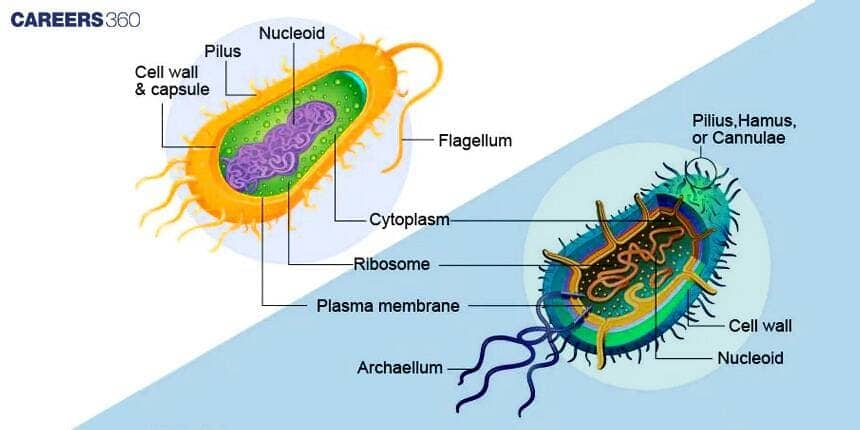Difference Between Archaea and Bacteria: Overview, Similarities & Differences
According to modern Biological Classification, Bacteria and Archaea are two groups of prokaryotic microorganisms (meaning they do not have a nucleus or membrane-bound organelles) that may appear similar but differ in many ways. Earlier grouped together, but later scientists discovered that Archaea are genetically closer to eukaryotes than to bacteria. The difference between Archaea and Bacteria, Archaea (without peptidoglycan) and Bacteria (with peptidoglycan) is based on their cell wall composition, membrane lipids, genetic material, and habitat adaptability.
This Story also Contains
- What are Archaea and Bacteria?
- Difference between Archaea and Bacteria
- Genetic differences of Archaea and Bacteria
- What are Archaea?
- What are Bacteria?
- Archaea and Bacteria Diagram
.jpg)
This article include one of the important topic of Class 11 Biology under Biological Classification as it explains the concept of variety among prokaryotes. It also shows how structural and molecular traits are used to divide living things into groups based on their evolutionary link between archaea and eukaryotes.
What are Archaea and Bacteria?
Bacteria and archaea are single-celled organisms called prokaryotes. Both of them are differentiated by structure, genetics, and metabolism. At the ecosystem level, they share decisive roles as decomposers, symbionts, and pathogens. Therefore, knowing the differences between Archaea and Bacteria is important for understanding kingdoms, evolutionary history, and ecological dynamics to identify their potential for biotechnology and medicine.
Also Read:
Commonly Asked Questions
Difference between Archaea and Bacteria
The difference between Archaea and Bacteria is a key concept in understanding microbial diversity in biology. Some basic difference between Archae and bacteria is discussed below:
Feature | Archaea | Bacteria |
Cell Wall | They do not have peptidoglycan and may have pseudopeptidoglycan or protein layers. | They contain peptidoglycan, a polymer of sugars and amino acids. |
Cell Membrane | They are made of ether-linked lipids with branched chains. | They are made of ester-linked lipids with straight chains. |
Flagella | Thinner, made of different proteins; unique motility mechanism. | Thicker, made of flagellin protein; rotary motor mechanism. |
Habitat | Often found in extreme environments like hot springs, salt lakes, and deep-sea vents. | Found in diverse environments, including soil, water, and host organisms. |
Antibiotic Sensitivity | Generally resistant to antibiotics. | Sensitive to many antibiotics. |
Commonly Asked Questions
Genetic differences of Archaea and Bacteria
The genetic makeup of Archaea and Bacteria reveals important molecular differences that set them apart, despite both being prokaryotes. Archaea and Bacteria exhibit notable differences in their genetic and molecular processes:
Genomic Organisation
As with eukaryotes, introns are common in archaeal but not bacterial genomes.
Along with the chromatin structure of their DNA, which resembles that of eukaryotes, with histone-like proteins, rather than the other proteins that associate with bacterial DNA.
DNA Replication, Transcription, and Translation Differences
Archaea use a class of enzymes for replicating DNA that are eukaryotic-like; bacteria have their distinct replication machinery.
Transcription and translation apparatus in Archaea include evolutionarily unique RNA polymerases as well as ribosomal proteins in the Archaea concerning Bacteria.
RNA Polymerase Structure and Function
Archaeal RNA polymerases are more closely related to eukaryotic RNA polymerases than to bacterial RNA polymerases.
They exhibit differences in promoter recognition and transcription regulation compared to bacterial RNA polymerases.
Commonly Asked Questions
What are Archaea?
Archaea are small, single-celled microorganisms, one of the three domains of life, the other two being Bacteria and Eukaryotes. Its existence was discovered in the 1970s when initially, it was thought of as Bacteria since they are prokaryotic but later it was realised that it is a different group based on genetic and biochemical distinctions. Some of the basic points are discussed below:
It possesses a unique type of cell membrane lipid called ether-linked phospholipid, unlike the Bacteria that have ester-linked phospholipid.
These microorganisms are extremophile class, as they thrive in extreme environments that include hot springs, salt lakes, and deep-sea hydrothermal vents.
They show highly diverse metabolic pathways, for example, methanogenesis, production of methane and various extremophilic adaptations - for thermophiles or halophiles, for example.
Examples of Archaea
Methanogens: These occur in anaerobic environments like swamps and the guts of animals, and they excrete methane due to their metabolism.
Thermophiles: This is an extremophilic species that dwells in the higher temperatures that are found in hot springs and geothermal areas.
Halophiles: Grow well in salt-rich surroundings such as salt lakes and hypersaline.
Commonly Asked Questions
What are Bacteria?
Bacteria are unicelled prokaryotic microorganisms that relate to the domain Bacteria. The first bacteria was discovered by Antonie van Leeuwenhoek in the 17th century. This laid the foundation for microbiology. Some of the basics are discussed below:
The cell wall of the bacterium is mainly composed of peptidoglycan.
Bacteria reproduce asexually by binary fission.
The metabolic pathways of bacteria are very diverse, including aerobic and anaerobic respiration, fermentation, and photosynthesis.
They exist everywhere in the environment: soil, water, and living tissues of organisms.
Examples of Bacteria
Escherichia coli, or E. coli: The bacterium is found in the intestines of humans and other animals. It has a role in digestion.
Staphylococcus aureus: This is a bacteria responsible for skin infection and, at times, serious diseases.
Cyanobacteria: The photosynthetic bacteria whose photosynthesis byproduct is oxygen. They have, in fact greatly, contributed to the Earth's Atmosphere and Aquatic Ecosystem.
Commonly Asked Questions
Archaea and Bacteria Diagram
The diagram below shows the cells of Archaea and bacteria. It highlights the key differences in their cell walls, membranes, and surface features.

Other useful resources:
Frequently Asked Questions (FAQs)